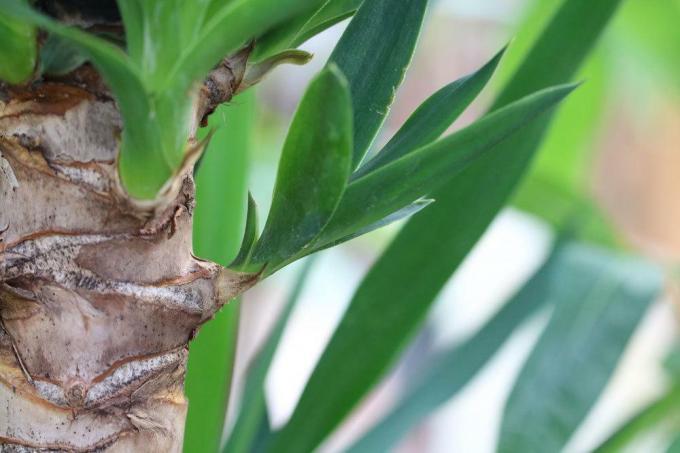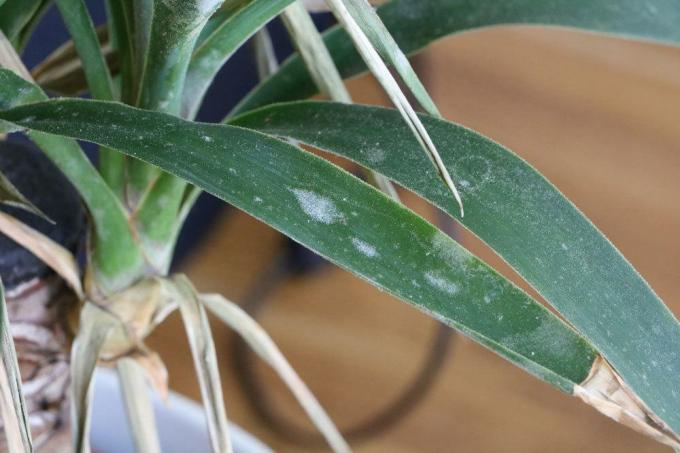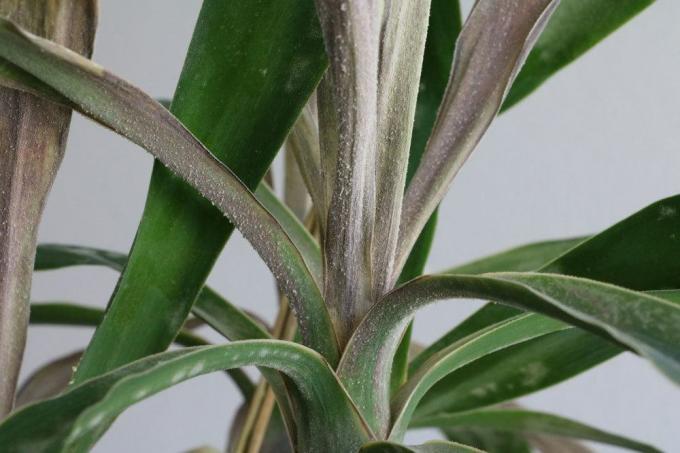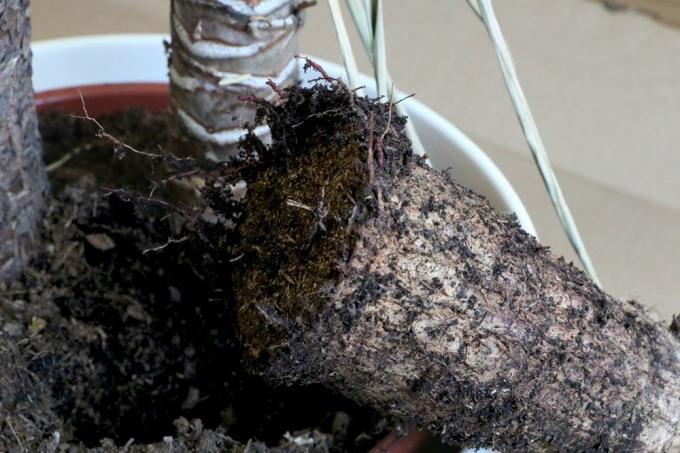
table of contents
- Dead leaf tips
- Leaf discoloration
- stains
- Countermeasures
- mildew
- Root rot
- Symptoms
- Countermeasures
- Cut
- Draw the palm as a new copy
Yucca palms are one of the easy-care plants that only need the right location and a permeable substrate to feel comfortable. But even palm lilies can suffer from a multitude of diseases that drain the vitality of the plants and, if left untreated, lead to the death of the plant. Most of these diseases are due to poor care, which makes countermeasures easier to use.
Dead leaf tips
Dead leaf tips are dry and bright, white in color. They announce themselves by the fact that they become lighter over time, but do not show up spots that would indicate other diseases. This disease is not an infection and is not caused by moisture, which is the main cause of many problems with drought tolerant yucca. The reason for this is too low PH value of the substrate, causing:
- Plant is under stress as cells die
- the tips of the leaves die off
- in addition, the tips of the leaves turn light, almost white
The desired pH value of the palm lilies is between 6.0 and 7.0, which shouldn't even be a problem with the calcareous water in Germany. If dead leaf tips appear, check the pH value of the soil and adjust it accordingly:
- 150 grams of calcium carbonate per square meter to gently raise the pH
- ten grams of basalt flour per liter of substrate to increase the pH value by one unit
You do not have to remove the dead leaf tips as long as no other disease has affected the yucca.
Leaf discoloration
Leaf discoloration is one of the typical diseases caused by incorrect care. These are not an infection or a pathogen; you just need to properly care for the plant. The typical leaf discolorations are either yellow or brown and are caused by the following Care errors:
- Watering too often without waterlogging: the entire leaf becomes discolored
- Lack of light on one side: one side of the leaf is discolored
Act on the cause. You can leave the leaves on the yucca without any problems, because they will fall off by themselves.
stains
Stains on palm lilies can be caused by a variety of Mushrooms and affect the health of the plant accordingly. These are transmitted either via drops that get onto the leaves or spores that are transferred by drafts. Since a yucca should never be watered from above and should not stand in the train, these diseases can be prevented with the right location and correct watering. However, an infection can always occur, with the following stain colors indicating diseases:
1. Gray
Gray discoloration is caused by spores of the genus Cytospora and occurs mainly in the gray palm lily (bot. Yucca aloifolia). First, the tips of the leaves and edges die, turn gray, and then gray spots appear. The reason for this is the use of water that is too warm while watering too often.
2. Rust-colored
If rust-colored spots appear, fungi of the genus Cercospora are to blame. These turn brown over time and indicate the infection. Over time, the spots grow to a size of over 60 millimeters and are clearly recognizable. It is best to only pour from below.
3. Brown and yellow
This discoloration is caused by the fungus Coniothyrium concentricum, which produces brown and yellow spots with a black border. The older leaves of the plant are particularly affected and the discoloration spreads so much that the entire leaf dies. Casting errors are also to be avoided here.
Countermeasures
For all of these diseases, proceed in the same way:
- keep infected plants away from other specimens
- Cut off infected plant material and dispose of with household waste
- Treat the plant with natural fungicides in case of light infestation
- for example, infusions based on nettles, field horsetail and tansy
- chemical fungicides must be used if the infection is more severe
- Fungicides based on copper and sulfur are recommended
- Broadband funds also work
- never use fungicides in the house!
tip: Discoloration can often occur via pests, which requires a completely different approach. Therefore, check whether the stains were caused by a pest infestation.
mildew
Powdery mildew is a fungal infection that mainly affects the leaves of the plant and occurs quite rarely. The most common cause of powdery mildew infection is either transmission through other plants that have the fungus or incorrectly cared for. Typical causes of the infection are:
- incorrect, usually too frequent, watering
- wrong fertilizer additions
- Lack of light
- wrong temperature
- Heating air, which strongly dries out the area around the plant
The mushroom Athelia rolfsii is responsible for powdery mildew, which mainly selects tomatoes and soybeans as host plants. However, it can attack the yucca and can then be seen as a white coating on the leaves that can be wiped away with the hand. In the event of a slight infestation, the leaves are treated with a mixture of whole milk and water, as the lactic acid bacteria contained in it reliably kill the fungi. If there is a strong infestation, you have to cut off the affected leaves and areas and dispose of them in the household waste. Then check whether there is a possible maintenance error. After cutting, don't forget to disinfect the scissors.

tip: A clinical picture similar to powdery mildew can be caused by an infestation with gall mites. Once you inspect the leaves and it is not a wipe-off coating but small mites, you need to take action against gall mites.
Root rot
Root rot is one of the most serious diseases of the yucca as it is major damage can cause and also requires a lot of maintenance so that this can be overcome. The cause of root rot in the yucca is actually always involved Waterlogging together. If the fleshy root ball is literally in the water, it begins to become soft and susceptible to fungi of the genus Fusarium, which lead to the aforementioned root rot and form mold. Various putrefactive bacteria can also be the cause of this disease. But not only waterlogging is a breeding ground for the disease, because the following Care errors also lead to:
- Compacted substrate because it was not repotted sufficiently
- Injuries to the trunk, for example due to pruning or if the plant falls over
- Humidity over 85 percent
- permanent, insufficient drainage without waterlogging
- planted too deep in the pot
- Palm lily grows weakly
- Roots are damaged during repotting or other causes
- Location too cool in winter quarters
- dirty cutting tools that can lead to infection
- rarely infection by fungi or bacteria of an already infected plant
- Bacteria or fungi are introduced when you buy them
Symptoms
Despite these causes, waterlogging is the yucca's biggest problem. The plants originally come from arid and semi-arid regions of the world and can therefore easily tolerate longer periods of drought. Numerous diseases such as root rot can be avoided if you do not water too often, especially over the winter. It is during this time of year that the disease is most common because many owners avoid watering the yucca less. Root rot is also known as stem rot and is associated with a wide variety of symptoms.
- Mold formation on the trunk, in the substrate and on the substrate surface
- a musty smell emanating from the earth
- Trunk is soft; a particularly clear symptom of the disease
- Stunted stature
- yellowish discolored leaves
- rotten roots
Countermeasures
Cut
Since there is no remedy for the fungi and bacteria that are responsible for the root rot, only vigorous pruning measures remain. As a result of this, the palm lily loses a large part of its plant material, but it can sprout again afterwards. Proceed as follows:
1. Remove the plant completely from the pot and remove all rotten roots with disinfected scissors. Putrid roots are mushy, brown, and smelly. If there are still healthy roots, the disease is not far advanced, which is a good sign.
2. Also cut off any affected areas on the plant that are also soft. Yellow leaves are also included. Check the yucca very carefully for spots with mold and those that are soft. So also cut back all the shoots that are affected by the rot.
3. Then wash the root ball of the plant thoroughly and dry it well afterwards.
4. Dispose of the old substrate in the household rubbish, wash the pot well and check whether it has drainage holes. Then fill it with fresh, well-drained substrate and place the plant in the soil. After that, be careful not to water too much so that the disease does not reappear. Cut off parts are disposed of with household waste, as these would lead to the formation of further fungi on the compost.
Draw the palm as a new copy
If the root rot is well advanced and there is a lot of mold, you need to take another measure. Especially if the entire root area and parts of the trunk are rotten, the entire plant must be disposed of because it can no longer live and is only a breeding ground for fungi and bacteria would. However, you do not have to dispose of the yucca, you can use the last remaining remains draw a new copy:
1. Take the plant out of the pot and completely remove the substrate again.
2. Cut the plant back until you hit solid wood. You need to be generous here and cut away as much as possible so that there really aren't any soft or rotten spots left. Even if you only end up with a small piece of the original plant, this step is necessary.
3. Now plant the solid parts like cuttings in fresh substrate and grow new plants from them. Above all, pay attention to the right care and remember: do not water too much! You can even wait to water until the plant is slightly drooping its leaves. As long as there is no discoloration of the leaves, but rather they are only slightly drooping, you can water.

tip: Palm lilies planted in the garden suffer less from root rot and generally from diseases in contrast to the specimens in the tub. The reason for this is the better drainage of the soil, which in most cases can prevent waterlogging.




